Empowerment and education – new mandates for designers, from Pune Design Festival 2021
The Pune Design Festival wrapped up with calls to action for designers to broaden their scope and purpose, and for educators to connect with new realities.
The annual Pune Design Festival wrapped up its 15th edition with a string of thought-provoking sessions on design purpose and education. Held online due to the COVID-19 pandemic, the seven-day event featured 30 speakers as well as 10 workshops.
See earlier write-ups on the 2021 and 2019 edition here, and the series of conferences and webinars (2017-2020). Our d.Zen (‘Design Zen’) section offers more resources on design.
See also my reviews of the related books Digital Open Innovation, Fusion Innovation, A Beautiful Constraint, and Frugal Innovation. Check out our pick of Top Quotes of 2020 and 2019 on Design, and The ‘8 Is’ Framework for Design Thinking.
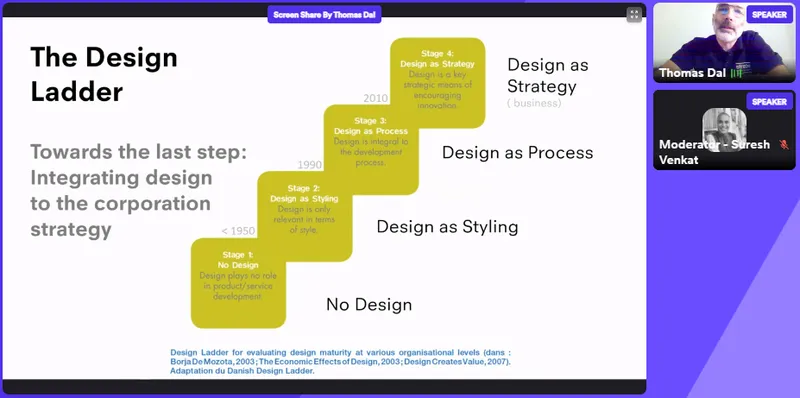
Thomas Dal at PDF
Design and the environment
Our world is facing a planetary crisis with mounting plastic waste and endangered biodiversity, cautioned Thomas Dal, Director and Dean, Strate School of Design, Bangalore. There’s a big gap, however, between wanting to save the world and actually taking concrete steps at the personal and corporate levels.
Some companies have successfully moved along the maturity curve of design as style, process, and strategy. But the ultimate stage in the ladder is design as politics, or design with broader considerations of the environment and society, Thomas urged.
Unfortunately, a number of companies carry out ‘greenwashing,’ or thinly disguised PR fronts without substantial commitment to the reduction of carbon footprints. This will require a clean break from a gradual evolution to “rupture innovation”, he argued.
“Spaceship Earth is all we have,” Thomas warned. He showed a range of examples of sustainable design and even conversion of waste (eg. cigarette butts) into wealth.
“Waste is valuable,” he explained. He pointed to how we can learn from nature and harness the power of algae to eliminate waste.
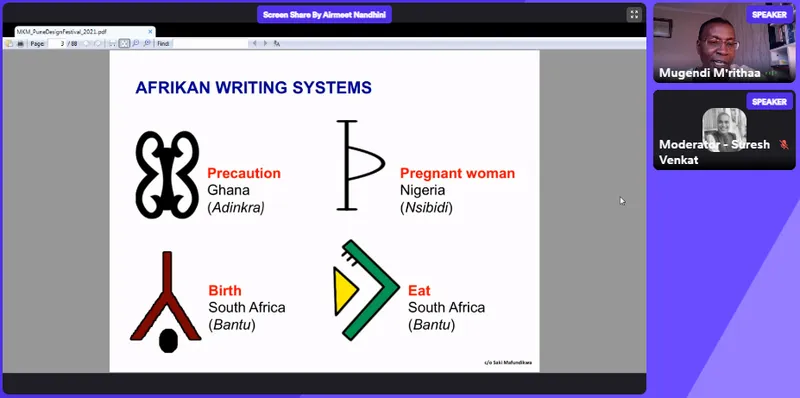
Mugendi M’Rithaa at PDF (i)
Community and commitment
The importance of socially-conscious design was highlighted by Mugendi M’Rithaa, a trans-disciplinary industrial designer who has studied in Kenya, the US, India, and South Africa.
‘Afrika’ (a new and progressive interpretation of ‘Africa’ from within) is gaining global interest for its original approaches to creativity, ingenuity, and humanity. It has creative confidence and a broadly-appealing design ethos, he showed. See also my interview with Ravi Naidoo, Founder of Interactive Africa and Design Indaba, from the DesignUp 2018 conference.
Building on the characters of African writing systems, Mugendi showcased an outstanding range of examples of African design. They build on local cultural concepts of mutual assistance, collective self-reliance, and consensus-building.
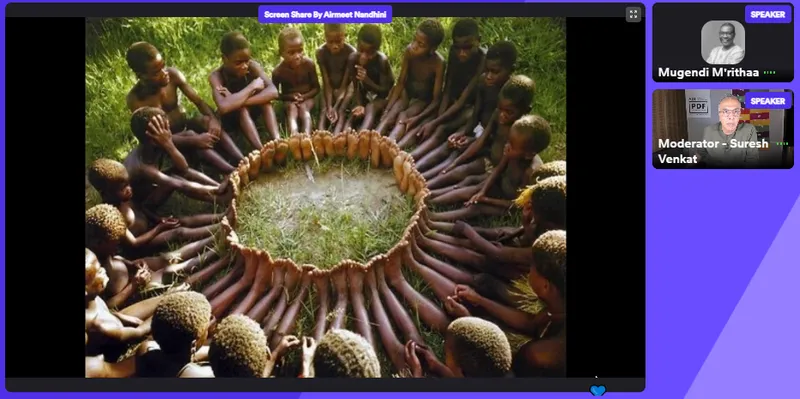
Mugendi M’Rithaa at PDF (ii)
For example, the principle of Ubuntu translates into I am because we are; I participate, therefore I am; and We co-design, therefore we transform. (See also my pocketbook on African Proverbs, downloadable as apps: Apple and Android.)
Design should be not just about empowerment but emancipation, Mugendi emphasised.
He showed examples of barkcloth products (Marie-Sar) and even pandemic-era masks with African designs. The continent of Africa and the sub-continent of India have a lot in common in terms of unity in diversity, he explained, calling for more cultural exchanges between the lands.
African design can teach the world about the importance of community and spirituality, without silos between body and mind, he argued.
Supporting the broader design profession
Professionals need not be confined to silos of their fields and sub-fields, as shown in an inspiring talk by Kelley Cheng, Founder and Creative Director, . The award-winning Singaporean polymath showcased her diverse roles as editor, writer, curator, spatial designer, graphic designer, video director, interactive designer, and educator.

Kelley Cheng at PDF
She gives back to the design community by showcasing their work in books, exhibitions, and documentaries. She has taught at NUS, NTU, and LaSalle College of the Arts. Her work reflected her passion and love for the field.
Sample works include the Inkpulse book on artist Yeo Shih Yun, Singapore Architect magazines, fundraising for migrant workers during the pandemic via sales of specially designed T-shirts, and spaces like 15 Minutes to showcase the works of young designers.
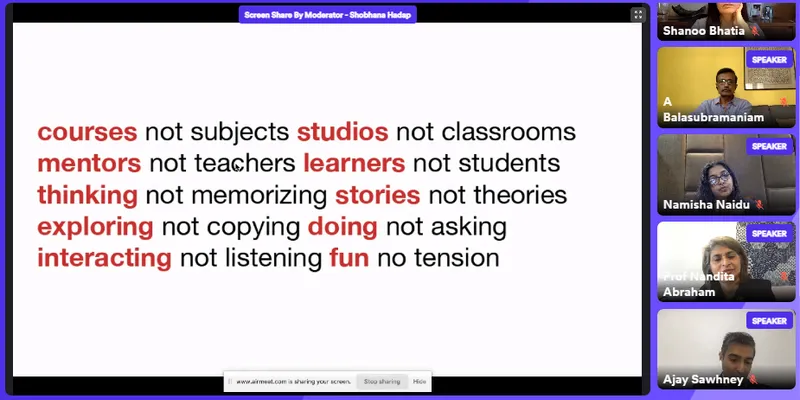
Design Education panel (1)
Educational foundations
New frontiers in design education were debated by an industry and academic panel, featuring Ajay Sawhney, Shobhana Hadap, Shanoo Bhatia, Maliha Sultan, A Balasubramaniam, Namisha Naidu, Gaurav Juyal, and Nandita Abraham.
Designers have curiosity and positivity, they are dreamers as well as problem-solvers. They are visually-oriented thinkers and doers, and early adopters of technology. They have a passion and a bias towards action, the panellists explained.
A good design education gives more than a degree, and orients designers towards goals beyond a 9-to-5 job. It blends intuitive as well as logical approaches to problem-solving, with a scientific approach in addition to customer empathy.
By nature, design is becoming more inter-disciplinary, the panel emphasised. Though design students have lost valuable classroom and studio time due to the pandemic, new learnings and opportunities have emerged.
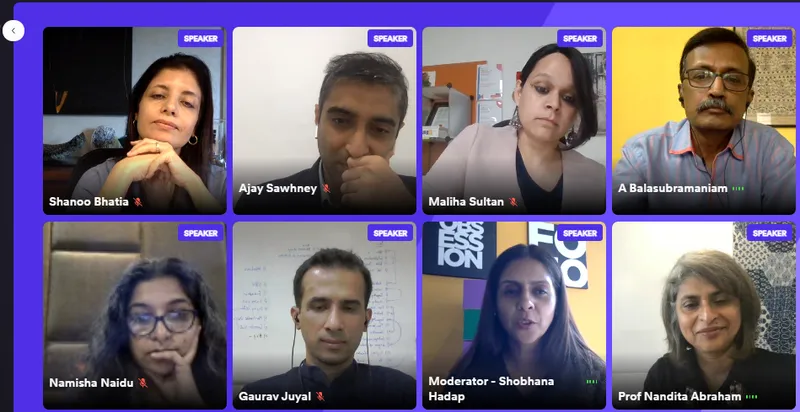
Design Education panel (2)
The younger generation of students is more digitally savvy and globally oriented. They value design experiences beyond the classroom, the panellists observed. They also advocated sensitising of design as a discipline at the school level, not just colleges.
In sum, design is not just about a skillset or toolset, but a mindset, the panel signed off.
Edited by Teja Lele




![[Startup Bharat] How this Udaipur-based apparel startup aims to represent the young souls of India](https://images.yourstory.com/cs/2/b094ec506da611eab285b7ee8106293d/imageonline-co-logoadded7-1614057901782.jpg?fm=png&auto=format&h=100&w=100&crop=entropy&fit=crop)





